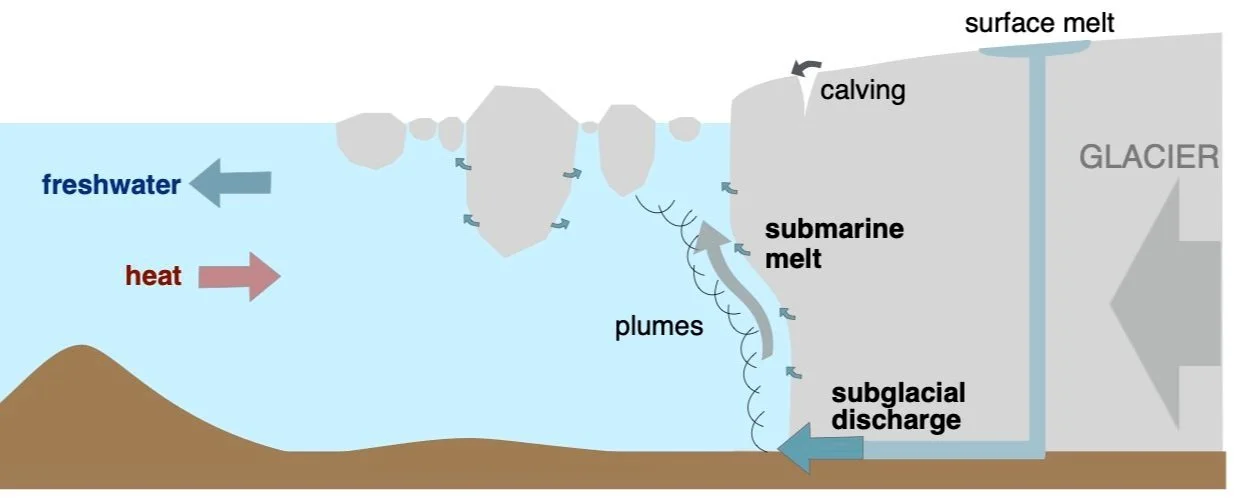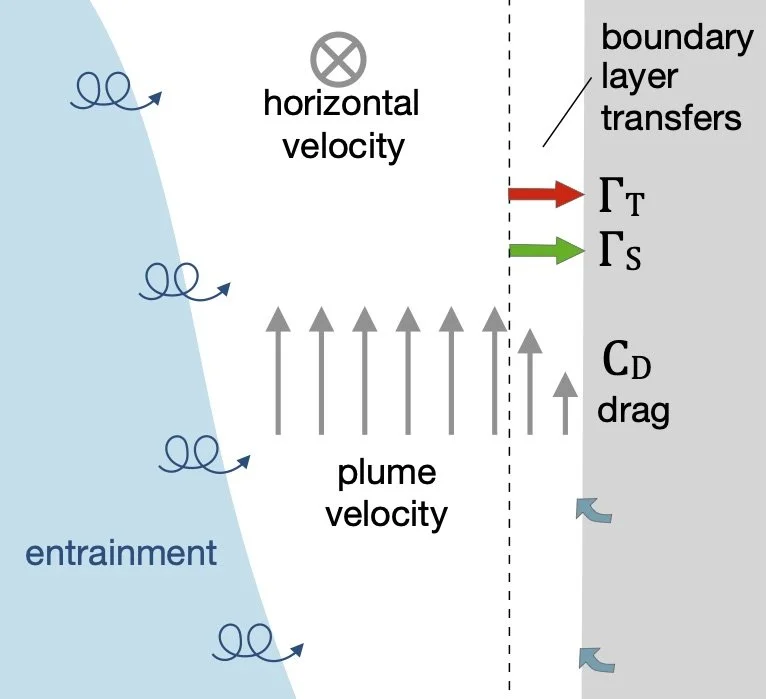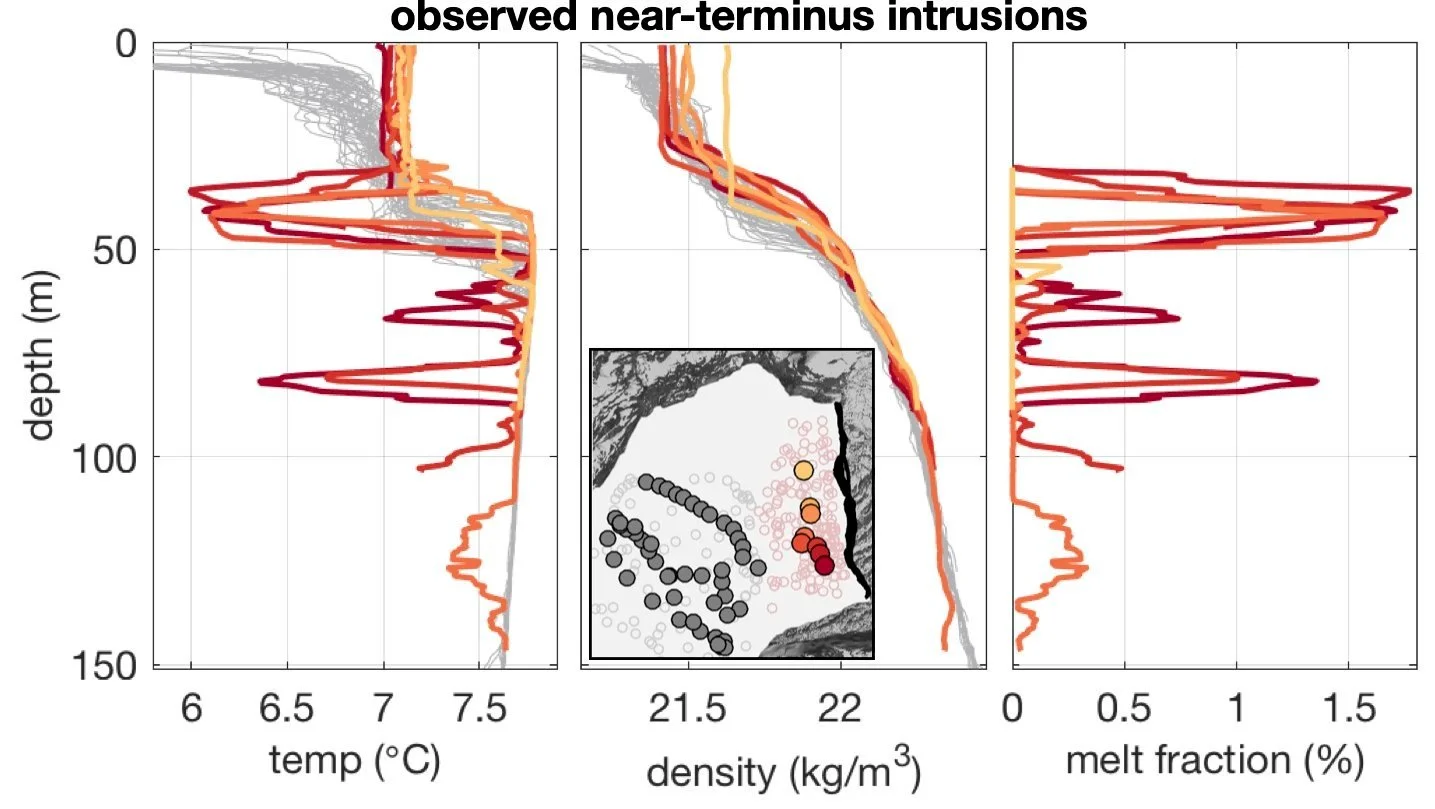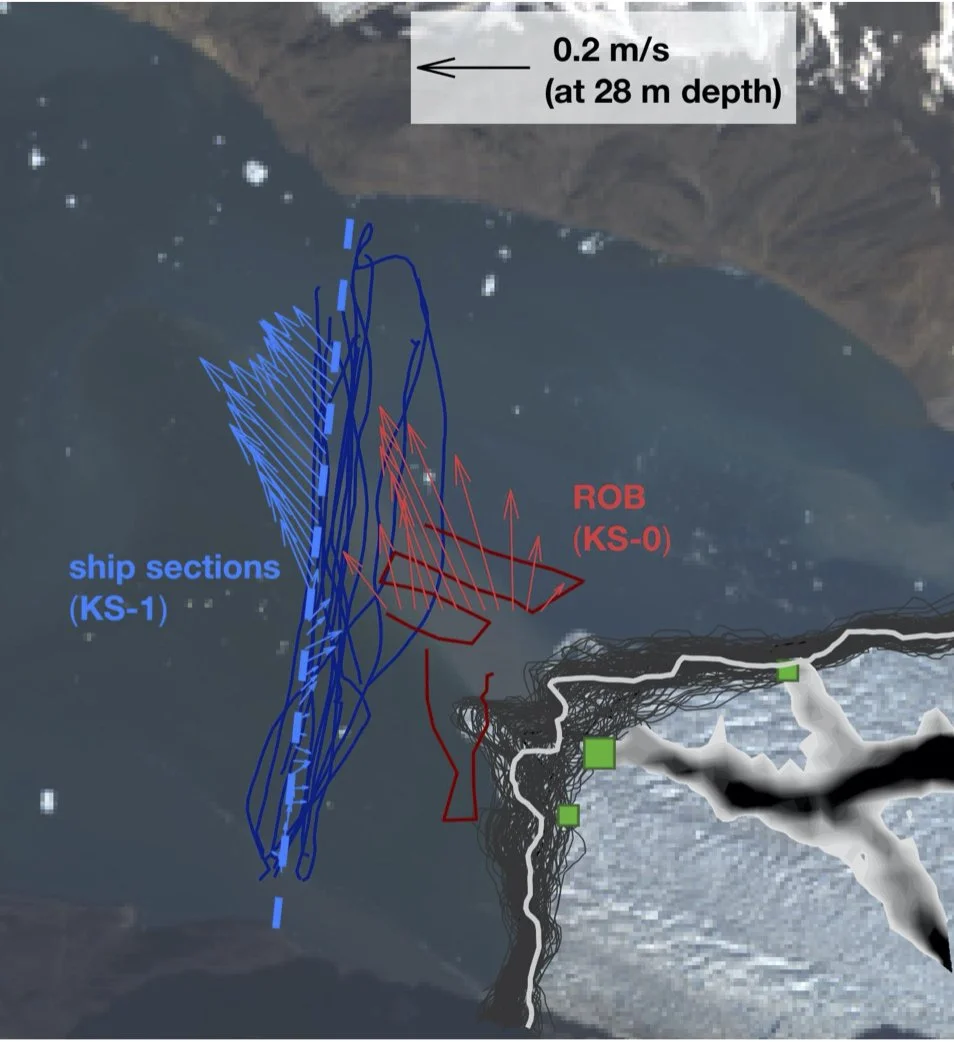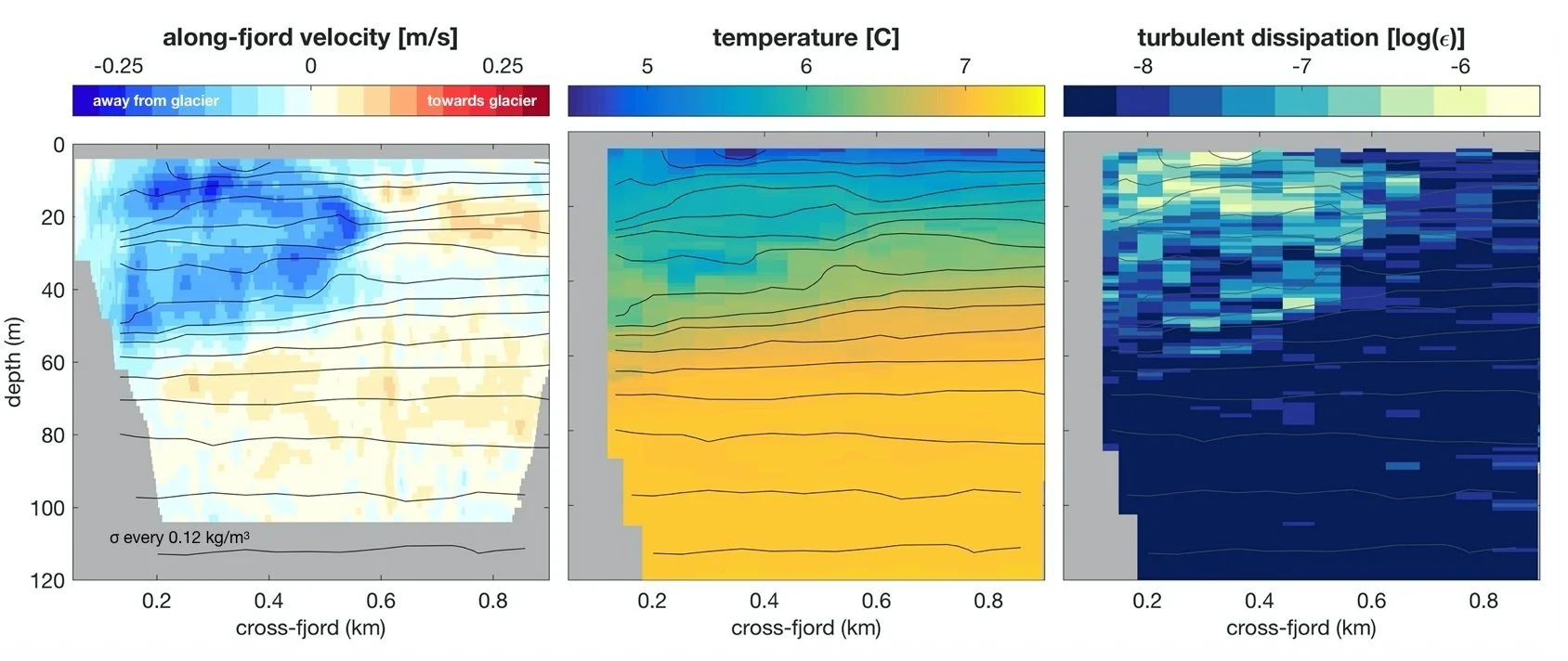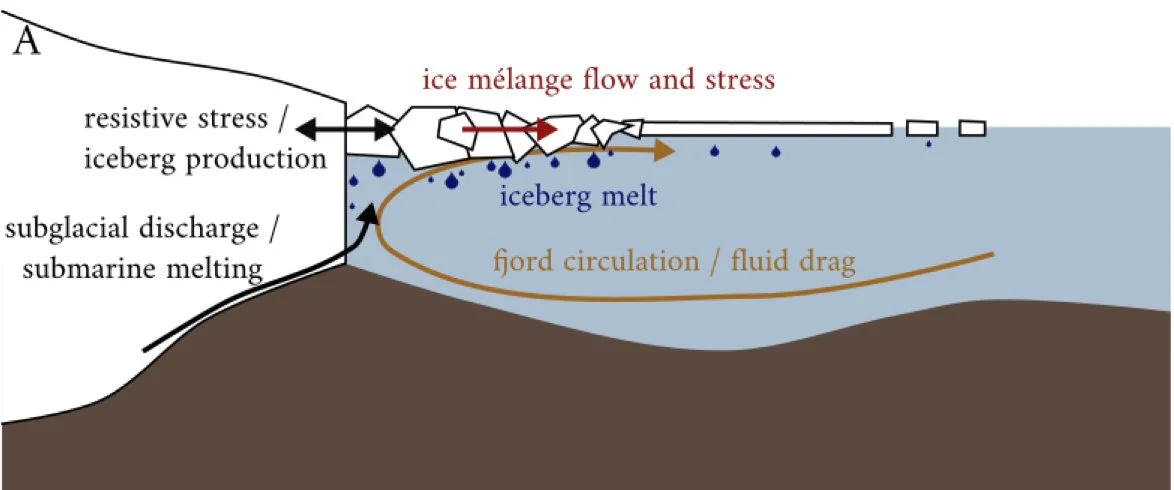Our research group focuses on interactions between the ocean and cryosphere, coastal dynamics, and polar processes. The shrinking ice sheets of Greenland and Antarctica are a significant and growing contributor to sea level rise, yet our ability to predict sea level is hampered by a limited understanding of ocean-glacier interactions. Ocean warming has been implicated as a driver of glacier acceleration and retreat, with enhanced submarine melting as the presumed connection. However, we have almost no direct measurements of this melting and only a nascent understanding of ocean dynamics near glaciers. Both directions of ocean-glacier interactions are of interest: how does the ocean drive submarine melting and glacier retreat, and how does freshwater discharge from glaciers and ice sheets affect ocean circulation? Our research group explores these questions across a range of scales – from the ocean-ice boundary layer to the regional circulation around Greenland – through the integration of observations, theory, and modeling.
Freshwater fluxes from glaciers
One area of focus is developing novel approaches to measuring the glacial freshwater fluxes from submarine melting, subglacial discharge, and surface runoff. Submarine melting of glaciers is the critical link that allows ocean warming to drive glacier retreat. However, for tidewater glaciers (common in Greenland, West Antarctica, Alaska, Patagonia and elsewhere), submarine melt rates and glacial freshwater fluxes are largely unconstrained by observations. Our work explores a variety of new methods to measure these freshwater fluxes, and most recently, to explore the relationship between submarine melting and subglacial discharge – a critical relationship for modeling ocean-glacier interactions.
Ice-ocean boundary layer processes
At the smallest scales, submarine melt is controlled by boundary layer processes that modulate the exchange of heat and salt between the ocean and ice. Assumptions about the boundary layer structure and dynamics are embedded in the common melt parameterizations used to predict melt rates; however, to date, we have no direct measurements of the boundary layer at any tidewater glaciers. These boundary layer processes are the focus of a new NSF project entitled: “How fast do tidewater glaciers melt? Quantifying the processes that control boundary layer transport across the ice-ocean interface.” In collaboration with Oregon State University and University of Oregon, we will be using ROVS to make measurements of melt and boundary layer properties at the ocean-ice interface in 2022-2024.
This upcoming work is motivated by our recent results from surveying with autonomous surface vessels at the terminus of LeConte Glacier, Alaska. While previous studies have assumed that the majority of melting occurs where energetic discharge plumes rise along the ice face, we discovered that ambient melt – where ice melts directly into the ambient fjord waters, away from discharge plumes – is a large contributor to the total termimus melt. These results help explain why existing models and theory underpredict melt rates, often by orders of magnitude.
Plumes & near-glacier ocean dynamics
At slightly larger scales (tens of meters to kilometers), submarine melt and subglacial discharge drive buoyant upwelling plumes which transition into horizontally outflowing plumes. These plumes modulate the flux of ocean heat to melt glacial ice and the dilution of meltwater as it is mixed and exported into the ocean. The turbulent dynamics of these plumes cannot be directly resolved in any global, regional, or even fjord-scale models. Instead, ocean-glacier models typically rely on buoyant plume theory to parameterize plumes and their associated submarine melting. Using a variety of data from Greenland and Alaska, complemented by numerical models, we are exploring these plume dynamics and testing the existing theory and parameterizations for plumes. Ongoing work aims to track the evolution of plumes from their energetic upwelling phase to their downstream outflow into the fjord – a critical transition for understand how glacial freshwater inputs drive fjord- and larger-scale ocean circulation. Beyond the plume themselves, we are also examining other sources of high-frequency variability – particularly internal gravity waves – that energize the ice-ocean boundary layer and enhance melting.
Regional circulation in fjords & polar oceans
Around Greenland, Alaska, West Antarctica and elsewhere, fjords connect tidewater glaciers to the open ocean, forming a conduit for the transport of heat and meltwater. Circulation within these fjords and their adjacent continental shelves will dictate the oceanic properties that reach glaciers and also control the fate of glacial meltwater as it spreads into the ocean. We are examining a variety of fjord drivers – buoyancy forcing from glaciers, wind forcing, shelf-driven flows, etc – using a combination of of surveys, moorings, and numerical models.
An ongoing NSF-funded project, “Investigating the exchange flow in glacial fjords through an estuarine lens”, aims to explore the fundamental dynamics of a glacier’s buoyancy-driven circulation and its interaction with external forcings. While glacial fjords are fundamentally estuaries – coastal embayments where terrestrial freshwater mixes into seawater – they do not fit easily into traditional estuarine paradigms. However, we are building on the many useful frameworks from the coastal and estuarine world to investigate fjord dynamics through an estuarine lens, drawing on better-studied processes in standard estuaries and attempting to expand estuarine paradigms to include glacial fjords.
Ice mélange & icebergs
Adapted from Amundson et al (2020).
At many of the largest outlet glaciers in Greenland, an ice mélange of icebergs and sea ice forms a rigid matrix that can affects both the glacier (via back-stress on the terminus) and the ocean (via meltwater input and drag). As part of an NSF-funded project entitled “GLACIOME: Developing a comprehensive model of the coupled glacier-ocean-mélange system”, we are examining the role of ice mélange as an integral part of the coupled glacier-ocean system and assessing its impact on glacier stability. The Rutgers component of this project is focused on the impact of icebergs on ocean properties and dynamics, and role of ocean dynamics in modulating iceberg melt rates.
